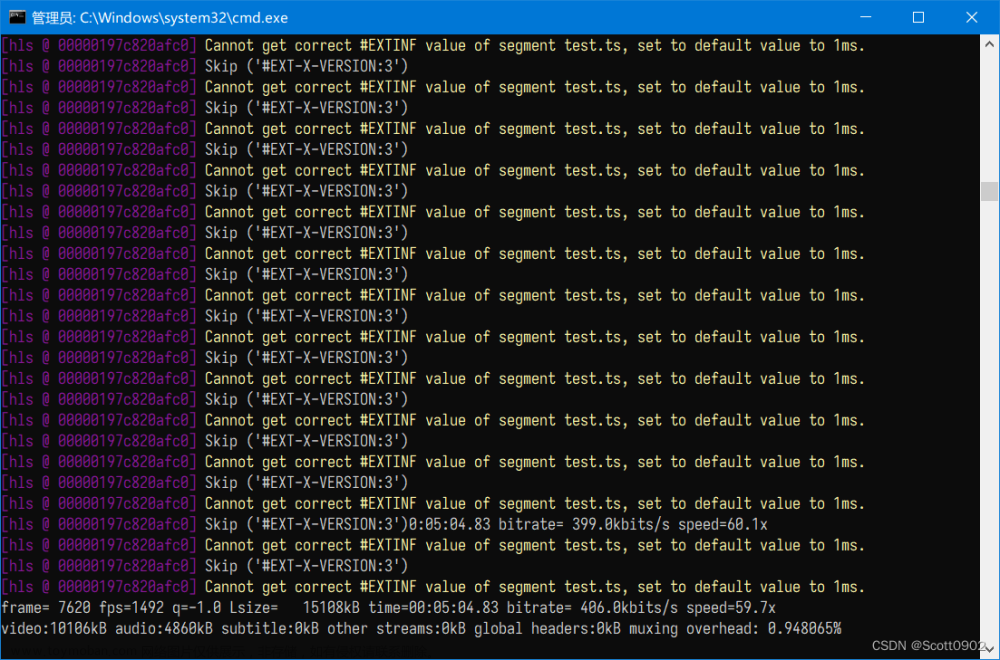1、 封装MP4原理:
每一帧音频或视频都有一个持续时间:duration:
采样频率是指将模拟声音波形进行数字化时,每秒钟抽取声波幅度样本的次数。
。正常人听觉的频率范围大约在20Hz~20kHz之间,根据奈奎斯特采样理论,为了保证声音不失真,采样频率应该在40kHz左右。常用的音频采样频率有8kHz、
11.025kHz、22.05kHz、16kHz、37.8kHz、44.1kHz、48kHz等,如果采用更高的采样频率,还可以达到DVD的音质
对采样率为44.1kHz的AAC音频进行解码时,一帧的解码时间须控制在23.22毫秒内。
背景知识:
(一个AAC原始帧包含一段时间内1024个采样及相关数据)
分析:
1) AAC
音频帧的播放时间=一个AAC帧对应的采样样本的个数/采样频率(单位为s)
一帧 1024个 sample。采样率 Samplerate 44100KHz,每秒44100个sample, 所以根据公式 音频帧的播放时间=一个AAC帧对应的采样样本的个数/采样频率
当前AAC一帧的播放时间是= 1024*1000000/44100= 22.32ms(单位为ms)
2) MP3
mp3 每帧均为1152个字节, 则:
frame_duration = 1152 * 1000000 / sample_rate
例如:sample_rate = 44100HZ时,计算出的时长为26.122ms,这就是经常听到的mp3每帧播放时间固定为26ms的由来。
3)H264
视频的播放时间跟帧率有关 frame_duration = 1000/fps
例如:fps = 25.00 ,计算出来的时常为40ms,这就是同行所说的40ms一帧视频数据。
理论上的音视频(播放)同步是这样的:
由此得到了每一帧数据的持续时间,音视频交叉存储在容器中:一个时间轴:
时间轴:0 22.32 40 44.62 66.96 80 89.16 111.48 120 ................
音 频 :0 22.32 44.62 66.96 89.16 111.48 ................
视 频 :0 40 80 120 ................
即视频的持续时间相加 和音频的持续时间相加作比较,谁小写入哪个。
但实际情况(播放)是不成立的
1:首先解决一个问题
为什么不 音频播音频的 视频播视频的 即上面的 到 第22.32ms播一帧音频 ,到40ms播一帧视频。
因为这个22.32ms 或40ms是算不准的或者说和声卡播的时间是不一样的。这里就需要知道声卡播一帧/或者说播放一个buf音频需要多长时间。
2:声卡每次播一个采样点 而不是一帧。声音当一个采样点丢失了都可以听出来,视频则不然。

3:音视频同步方式:1----回调方式
假设声卡有两块缓存都是存放要播放的声音pcm的 一直在播放"B"buf 首先确定几点
(1)buf大小是固定的这样播放一个buf的时间就是固定的,假设30ms;
(2)当buf“B”播放完毕即buf用完,再播放buf“A",保证音频pcm一直都连续
(3)当一个buf播放完毕,那说明系统(声卡)过了30ms, 这时候有可能真正的时间过了40ms(这里不用关心),这里则通过回调得到一次时间30ms;
(4)再去用视频对应音频的30ms,这时候的时间就是准确的:
时间轴:0 30 60 90 120 ................
音 频 :0 22.32 44.62 66.96 89.16 111.48 ................
视 频 :0 40 80 120 ................
(5)这里有个问题就是 视频中 30ms 到40ms 这中间的10ms是怎么算出来的,这个是不用关心的,因为人的眼睛10ms是看不出来的,
即当音频的30ms一次回调时,就可以播放第二帧视频,如上图
第一次回调(30ms)---播(40ms)视频,
第一次回调(60ms)---播(80ms)视频,
第一次回调(90ms)---不播视频,
第一次回调(120ms)---播(120ms)视频。

4:音视频同步方式:1----阻塞方式
还是看上面的图
(1)buf"B"一直在播放,传入buf"A"的外部buf把数据给buf"A"后 不立即返回,等到buf"B"播放完成再返回,
这时从传入到经过阻塞出来就是一个buf的时间例如上面的30ms。
(2)然后buf"A"一直在播放,传入buf"B"的外部buf把数据给buf"B"后 不立即返回,等到buf"A"播放完成再返回,
这时从传入到经过阻塞出来就是一个buf的时间例如上面的30ms。
(3)循环上面(1)(2),即得到了如回调方式同样的那个30ms时间。下面和回调方式一样,见回调方式(4)(5)。
2、基于FFmpeg的封装格式处理:
本文记录一个基于FFmpeg的视音频复用器(Simplest FFmpeg muxer)。视音频复用器(Muxer)即是将视频压缩数据(例如H.264)和音频压缩数据(例如AAC)合并到一个封装格式数据(例如MKV)中去。如图所示。在这个过程中并不涉及到编码和解码。

本文记录的程序将一个H.264编码的视频码流文件和一个MP3编码的音频码流文件,合成为一个MP4封装格式的文件。
流程
程序的流程如下图所示。从流程图中可以看出,一共初始化了3个AVFormatContext,其中2个用于输入,1个用于输出。3个AVFormatContext初始化之后,通过avcodec_copy_context()函数可以将输入视频/音频的参数拷贝至输出视频/音频的AVCodecContext结构体。然后分别调用视频输入流和音频输入流的av_read_frame(),从视频输入流中取出视频的AVPacket,音频输入流中取出音频的AVPacket,分别将取出的AVPacket写入到输出文件中即可。其间用到了一个不太常见的函数av_compare_ts(),是比较时间戳用的。通过该函数可以决定该写入视频还是音频。

本文介绍的视音频复用器,输入的视频不一定是H.264裸流文件,音频也不一定是纯音频文件。可以选择两个封装过的视音频文件作为输入。程序会从视频输入文件中“挑”出视频流,音频输入文件中“挑”出音频流,再将“挑选”出来的视音频流复用起来。
PS1:对于某些封装格式(例如MP4/FLV/MKV等)中的H.264,需要用到名称为“h264_mp4toannexb”的bitstream filter。
PS2:对于某些封装格式(例如MP4/FLV/MKV等)中的AAC,需要用到名称为“aac_adtstoasc”的bitstream filter。
简单介绍一下流程中各个重要函数的意义:
avformat_open_input():打开输入文件。
avcodec_copy_context():赋值AVCodecContext的参数。
avformat_alloc_output_context2():初始化输出文件。
avio_open():打开输出文件。
avformat_write_header():写入文件头。
av_compare_ts():比较时间戳,决定写入视频还是写入音频。这个函数相对要少见一些。
av_read_frame():从输入文件读取一个AVPacket。
av_interleaved_write_frame():写入一个AVPacket到输出文件。
av_write_trailer():写入文件尾。
代码
下面贴上代码:
/**
* 最简单的基于FFmpeg的视音频复用器
* Simplest FFmpeg Muxer
* 本程序可以将视频码流和音频码流打包到一种封装格式中。
* 程序中将AAC编码的音频码流和H.264编码的视频码流打包成
* MPEG2TS封装格式的文件。
* 需要注意的是本程序并不改变视音频的编码格式。
*
* This software mux a video bitstream and a audio bitstream
* together into a file.
* In this example, it mux a H.264 bitstream (in MPEG2TS) and
* a AAC bitstream file together into MP4 format file.
*
*/
#include <stdio.h>
#define __STDC_CONSTANT_MACROS
#ifdef _WIN32
//Windows
extern "C"
{
#include "libavformat/avformat.h"
};
#else
//Linux...
#ifdef __cplusplus
extern "C"
{
#endif
#include <libavformat/avformat.h>
#ifdef __cplusplus
};
#endif
#endif
/*
FIX: H.264 in some container format (FLV, MP4, MKV etc.) need
"h264_mp4toannexb" bitstream filter (BSF)
*Add SPS,PPS in front of IDR frame
*Add start code ("0,0,0,1") in front of NALU
H.264 in some container (MPEG2TS) don't need this BSF.
*/
//'1': Use H.264 Bitstream Filter
#define USE_H264BSF 0
/*
FIX:AAC in some container format (FLV, MP4, MKV etc.) need
"aac_adtstoasc" bitstream filter (BSF)
*/
//'1': Use AAC Bitstream Filter
#define USE_AACBSF 0
int main(int argc, char* argv[])
{
AVOutputFormat *ofmt = NULL;
//Input AVFormatContext and Output AVFormatContext
AVFormatContext *ifmt_ctx_v = NULL, *ifmt_ctx_a = NULL,*ofmt_ctx = NULL;
AVPacket pkt;
int ret, i;
int videoindex_v=-1,videoindex_out=-1;
int audioindex_a=-1,audioindex_out=-1;
int frame_index=0;
int64_t cur_pts_v=0,cur_pts_a=0;
//const char *in_filename_v = "cuc_ieschool.ts";//Input file URL
const char *in_filename_v = "cuc_ieschool.h264";
//const char *in_filename_a = "cuc_ieschool.mp3";
//const char *in_filename_a = "gowest.m4a";
//const char *in_filename_a = "gowest.aac";
const char *in_filename_a = "huoyuanjia.mp3";
const char *out_filename = "cuc_ieschool.mp4";//Output file URL
av_register_all();
//Input
if ((ret = avformat_open_input(&ifmt_ctx_v, in_filename_v, 0, 0)) < 0) {
printf( "Could not open input file.");
goto end;
}
if ((ret = avformat_find_stream_info(ifmt_ctx_v, 0)) < 0) {
printf( "Failed to retrieve input stream information");
goto end;
}
if ((ret = avformat_open_input(&ifmt_ctx_a, in_filename_a, 0, 0)) < 0) {
printf( "Could not open input file.");
goto end;
}
if ((ret = avformat_find_stream_info(ifmt_ctx_a, 0)) < 0) {
printf( "Failed to retrieve input stream information");
goto end;
}
printf("===========Input Information==========\n");
av_dump_format(ifmt_ctx_v, 0, in_filename_v, 0);
av_dump_format(ifmt_ctx_a, 0, in_filename_a, 0);
printf("======================================\n");
//Output
avformat_alloc_output_context2(&ofmt_ctx, NULL, NULL, out_filename);
if (!ofmt_ctx) {
printf( "Could not create output context\n");
ret = AVERROR_UNKNOWN;
goto end;
}
ofmt = ofmt_ctx->oformat;
for (i = 0; i < ifmt_ctx_v->nb_streams; i++) {
//Create output AVStream according to input AVStream
if(ifmt_ctx_v->streams[i]->codec->codec_type==AVMEDIA_TYPE_VIDEO){
AVStream *in_stream = ifmt_ctx_v->streams[i];
AVStream *out_stream = avformat_new_stream(ofmt_ctx, in_stream->codec->codec);
videoindex_v=i;
if (!out_stream) {
printf( "Failed allocating output stream\n");
ret = AVERROR_UNKNOWN;
goto end;
}
videoindex_out=out_stream->index;
//Copy the settings of AVCodecContext
if (avcodec_copy_context(out_stream->codec, in_stream->codec) < 0) {
printf( "Failed to copy context from input to output stream codec context\n");
goto end;
}
out_stream->codec->codec_tag = 0;
if (ofmt_ctx->oformat->flags & AVFMT_GLOBALHEADER)
out_stream->codec->flags |= CODEC_FLAG_GLOBAL_HEADER;
break;
}
}
for (i = 0; i < ifmt_ctx_a->nb_streams; i++) {
//Create output AVStream according to input AVStream
if(ifmt_ctx_a->streams[i]->codec->codec_type==AVMEDIA_TYPE_AUDIO){
AVStream *in_stream = ifmt_ctx_a->streams[i];
AVStream *out_stream = avformat_new_stream(ofmt_ctx, in_stream->codec->codec);
audioindex_a=i;
if (!out_stream) {
printf( "Failed allocating output stream\n");
ret = AVERROR_UNKNOWN;
goto end;
}
audioindex_out=out_stream->index;
//Copy the settings of AVCodecContext
if (avcodec_copy_context(out_stream->codec, in_stream->codec) < 0) {
printf( "Failed to copy context from input to output stream codec context\n");
goto end;
}
out_stream->codec->codec_tag = 0;
if (ofmt_ctx->oformat->flags & AVFMT_GLOBALHEADER)
out_stream->codec->flags |= CODEC_FLAG_GLOBAL_HEADER;
break;
}
}
printf("==========Output Information==========\n");
av_dump_format(ofmt_ctx, 0, out_filename, 1);
printf("======================================\n");
//Open output file
if (!(ofmt->flags & AVFMT_NOFILE)) {
if (avio_open(&ofmt_ctx->pb, out_filename, AVIO_FLAG_WRITE) < 0) {
printf( "Could not open output file '%s'", out_filename);
goto end;
}
}
//Write file header
if (avformat_write_header(ofmt_ctx, NULL) < 0) {
printf( "Error occurred when opening output file\n");
goto end;
}
//FIX
#if USE_H264BSF
AVBitStreamFilterContext* h264bsfc = av_bitstream_filter_init("h264_mp4toannexb");
#endif
#if USE_AACBSF
AVBitStreamFilterContext* aacbsfc = av_bitstream_filter_init("aac_adtstoasc");
#endif
while (1) {
AVFormatContext *ifmt_ctx;
int stream_index=0;
AVStream *in_stream, *out_stream;
//Get an AVPacket
if(av_compare_ts(cur_pts_v,ifmt_ctx_v->streams[videoindex_v]->time_base,cur_pts_a,ifmt_ctx_a->streams[audioindex_a]->time_base) <= 0){
ifmt_ctx=ifmt_ctx_v;
stream_index=videoindex_out;
if(av_read_frame(ifmt_ctx, &pkt) >= 0){
do{
in_stream = ifmt_ctx->streams[pkt.stream_index];
out_stream = ofmt_ctx->streams[stream_index];
if(pkt.stream_index==videoindex_v){
//FIX:No PTS (Example: Raw H.264)
//Simple Write PTS
if(pkt.pts==AV_NOPTS_VALUE){
//Write PTS
AVRational time_base1=in_stream->time_base;
//Duration between 2 frames (us)
int64_t calc_duration=(double)AV_TIME_BASE/av_q2d(in_stream->r_frame_rate);
//Parameters
pkt.pts=(double)(frame_index*calc_duration)/(double)(av_q2d(time_base1)*AV_TIME_BASE);
pkt.dts=pkt.pts;
pkt.duration=(double)calc_duration/(double)(av_q2d(time_base1)*AV_TIME_BASE);
frame_index++;
}
cur_pts_v=pkt.pts;
break;
}
}while(av_read_frame(ifmt_ctx, &pkt) >= 0);
}else{
break;
}
}else{
ifmt_ctx=ifmt_ctx_a;
stream_index=audioindex_out;
if(av_read_frame(ifmt_ctx, &pkt) >= 0){
do{
in_stream = ifmt_ctx->streams[pkt.stream_index];
out_stream = ofmt_ctx->streams[stream_index];
if(pkt.stream_index==audioindex_a){
//FIX:No PTS
//Simple Write PTS
if(pkt.pts==AV_NOPTS_VALUE){
//Write PTS
AVRational time_base1=in_stream->time_base;
//Duration between 2 frames (us)
int64_t calc_duration=(double)AV_TIME_BASE/av_q2d(in_stream->r_frame_rate);
//Parameters
pkt.pts=(double)(frame_index*calc_duration)/(double)(av_q2d(time_base1)*AV_TIME_BASE);
pkt.dts=pkt.pts;
pkt.duration=(double)calc_duration/(double)(av_q2d(time_base1)*AV_TIME_BASE);
frame_index++;
}
cur_pts_a=pkt.pts;
break;
}
}while(av_read_frame(ifmt_ctx, &pkt) >= 0);
}else{
break;
}
}
//FIX:Bitstream Filter
#if USE_H264BSF
av_bitstream_filter_filter(h264bsfc, in_stream->codec, NULL, &pkt.data, &pkt.size, pkt.data, pkt.size, 0);
#endif
#if USE_AACBSF
av_bitstream_filter_filter(aacbsfc, out_stream->codec, NULL, &pkt.data, &pkt.size, pkt.data, pkt.size, 0);
#endif
//Convert PTS/DTS
pkt.pts = av_rescale_q_rnd(pkt.pts, in_stream->time_base, out_stream->time_base, (AVRounding)(AV_ROUND_NEAR_INF|AV_ROUND_PASS_MINMAX));
pkt.dts = av_rescale_q_rnd(pkt.dts, in_stream->time_base, out_stream->time_base, (AVRounding)(AV_ROUND_NEAR_INF|AV_ROUND_PASS_MINMAX));
pkt.duration = av_rescale_q(pkt.duration, in_stream->time_base, out_stream->time_base);
pkt.pos = -1;
pkt.stream_index=stream_index;
printf("Write 1 Packet. size:%5d\tpts:%lld\n",pkt.size,pkt.pts);
//Write
if (av_interleaved_write_frame(ofmt_ctx, &pkt) < 0) {
printf( "Error muxing packet\n");
break;
}
av_free_packet(&pkt);
}
//Write file trailer
av_write_trailer(ofmt_ctx);
#if USE_H264BSF
av_bitstream_filter_close(h264bsfc);
#endif
#if USE_AACBSF
av_bitstream_filter_close(aacbsfc);
#endif
end:
avformat_close_input(&ifmt_ctx_v);
avformat_close_input(&ifmt_ctx_a);
/* close output */
if (ofmt_ctx && !(ofmt->flags & AVFMT_NOFILE))
avio_close(ofmt_ctx->pb);
avformat_free_context(ofmt_ctx);
if (ret < 0 && ret != AVERROR_EOF) {
printf( "Error occurred.\n");
return -1;
}
return 0;
}
原文链接:基于FFmpeg的封装格式MP4(TS)ffmpeg ts封装cnhui2016的博客-CSDN博客
★文末名片可以免费领取音视频开发学习资料,内容包括(FFmpeg ,webRTC ,rtmp ,hls ,rtsp ,ffplay ,srs)以及音视频学习路线图等等。
见下方!↓↓↓↓↓↓↓↓↓↓↓↓↓↓↓↓↓↓↓↓↓↓↓↓↓↓↓↓↓↓↓↓↓↓↓↓↓文章来源:https://www.toymoban.com/news/detail-776442.html
文章来源地址https://www.toymoban.com/news/detail-776442.html
到了这里,关于基于FFmpeg的封装格式MP4(TS)的文章就介绍完了。如果您还想了解更多内容,请在右上角搜索TOY模板网以前的文章或继续浏览下面的相关文章,希望大家以后多多支持TOY模板网!











